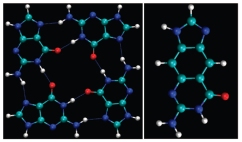We present a new computational strategy to evaluate the charge-transfer (CT) parameters for hole transfer in DNA. On the basis of a fragment-orbital approach, site energies and coupling integrals for a coarse-grained tight-binding description of the electronic structure of DNA are rapidly calculated using the approximative density functional method SCC-DFTB. The methodology is validated by extensive test calculations in comparison with DFT and ab initio reference data, demonstrating its high accuracy at low computational cost. Environmental effects are captured using a quantum mechanics molecular mechanics (QM/MM) coupling scheme, and dynamical effects are included by evaluating the CT parameters along classical molecular dynamics simulations. This combined methodology allows for a realistic treatment of CT processes in DNA.

We present a new computational strategy to evaluate the charge-transfer (CT) parameters for hole transfer in DNA. On the basis of a fragment-orbital approach, site energies and coupling integrals for a coarse-grained tight-binding description of the electronic structure of DNA are rapidly calculated using the approximative density functional method SCC-DFTB. The methodology is validated by extensive test calculations in comparison with DFT and ab initio reference data, demonstrating its high accuracy at low computational cost. Environmental effects are captured using a quantum mechanics molecular mechanics (QM/MM) coupling scheme, and dynamical effects are included by evaluating the CT parameters along classical molecular dynamics simulations. This combined methodology allows for a realistic treatment of CT processes in DNA.
